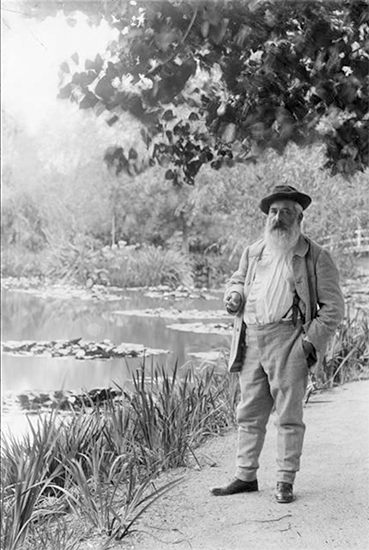Inspiration Close at Hand
Perspectives from The Artist’s Road

Claude Monet in His Gardens at Giverny
As many plein air events resume and artists are able to spread their wings to paint new landscapes, we have circumstances that are are still keeping us working close to home. But staying in one place throughout the seasons can be the best way to tune one’s eyes into seeing the nuances of shadow and light as they change in the landscape throughout each day as well as throughout the year.
Arguably the greatest artist who narrowed his travels and focused on his immediate surroundings for years was Claude Monet, creating many of what are considered his greatest works. Gustave Geffroy wrote about his friend, Monet, “The powerful landscapist who so strongly expressed the greatness of the sea, cliffs, rocks, ancient trees, rivers and cities, took pleasure in a sweet and charming simplicity, in this delightful corner of a garden, this tiny pond where blossoms some mysterious petal.”
It has been put forth that Monet’s increasing isolation to his home and gardens in Giverny relates directly to the Dreyfus Affair, the political scandal that saturated France from 1894 until 1906. Captain Alfred Dreyfus was wrongly accused and convicted of high treason, later to be pardoned, freed and eventually completely acquitted of the crime—his arrest and convictions strongly fueled by anti-Semitism.
The Dreyfus Affair created a sharp divide between the Impressionists. Monet, Mary Cassatt, Camille Pissarro and Paul Signac were among the artists supporting Dreyfus, while most notably, Edgar Degas and to a degree, Auguste Renoir were anti-Dreyfus.
Monet also championed Émile Zola who had written of the “stain” of the Dreyfus Affair and who had been, for his writing, convicted of libel and forced to leave the country. Monet signed the “Manifesto of the Intellectuals”, a document in support of Dreyfus. After Zola’s trial, the distraught Monet did not paint for eighteen months.
Once he took up his brush again, Monet completed over three hundred paintings. Geffroy wrote, “In this simplicity, is found everything the eye can see and surmise, an infinity of shapes and shades, the complex life of things.” The horrid Dreyfus Affair may be only one of the factors that brought Monet to focus his attention on his home and gardens in Giverny and away from the greater countryside of France. The gardens he cultivated and painted seem to have allowed him solace from his sorrow and his despair for his country.
There can be great creative benefits to painting a more intimate and personal world. Inspiration can be found far and wide or close at hand. Many artists have found those “diamonds in their own backyard” through the confinement of the pandemic. If you have paintings of your own gardens that you’d like to share, drop us a line.
For more fascinating information about Monet and his years at Giverny, read: Mad Enchantment – Claude Monet and the Painting of the Water Lilies by Ross King.
Monet and the Dreyfus Affair. Painting in Giverny.
Copyright Hulsey Trusty Designs, L.L.C. (except where noted). All rights reserved.

